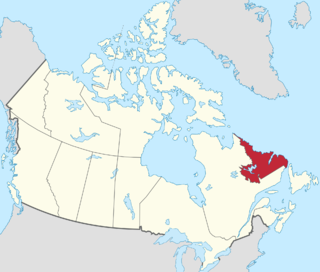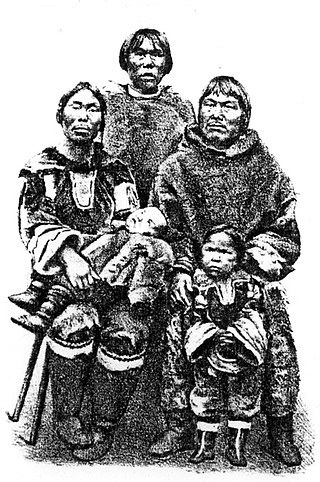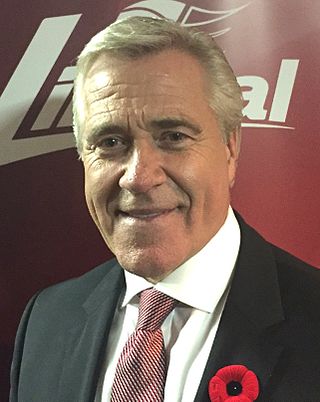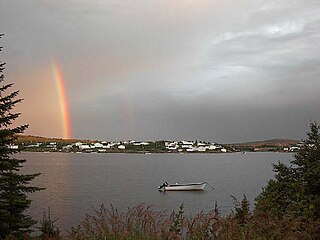
Labrador is a geographic and cultural region within the Canadian province of Newfoundland and Labrador. It is the primarily continental portion of the province and constitutes 71% of the province's area but is home to only 6% of its population. It is separated from the island of Newfoundland by the Strait of Belle Isle. It is the largest and northernmost geographical region in the four Atlantic provinces.

Nunatsiavut is an autonomous area claimed by the Inuit in Newfoundland and Labrador, Canada. The settlement area includes territory in Labrador extending to the Quebec border. In 2002, the Labrador Inuit Association submitted a proposal for limited autonomy to the government of Newfoundland and Labrador. The constitution was ratified on December 1, 2005, at which time the Labrador Inuit Association ceased to exist, and the new Government of Nunatsiavut was established, initially being responsible for health, education and cultural affairs. It is also responsible for setting and conducting elections, the first of which was executed in October 2006. An election for the ordinary members of the Nunatsiavut Assembly was held on May 4, 2010. Its incumbent president is Johannes Lampe who assumed office in 2016.

Nain is the northernmost permanent settlement in the Canadian province of Newfoundland and Labrador, within the Nunatsiavut region, located about 370 km (230 mi) by air from Happy Valley-Goose Bay. The town was established as a Moravian mission in 1771 by Jens Haven and other missionaries. As of 2021, the population is 1,204 mostly Inuit and mixed Inuit-European. Nain is the administrative capital of the autonomous region of Nunatsiavut.

Hopedale is a town located in the north of Labrador, the mainland portion of the Canadian province of Newfoundland and Labrador. Hopedale is the legislative capital of the Inuit Land Claims Area Nunatsiavut, and where the Nunatsiavut Assembly meets. As of the 2021 census, it has a population of 596.
Newfoundland and Labrador Hydro, commonly known as Hydro, is a provincial Crown corporation that generates and delivers electricity for Newfoundland and Labrador, as well as portions of Quebec and the north-eastern areas of the United States. Between 2007 and 2021, NL Hydro was a subsidiary of the provincial Crown-owned energy holding company Nalcor Energy.

Rigolet is a remote, coastal Labrador community established in 1735 by French-Canadian trader Louis Fornel. The town is the southernmost officially recognized Inuit community in the world. Located on Hamilton Inlet, which is at the entrance to fresh water Lake Melville; Rigolet is on salt water and is accessible to navigation during the winter. Although there is no road access, the community is accessible by snowmobile trail, the Rigolet Airport, or seasonally via a coastal ferry from Happy Valley-Goose Bay.

Abraham Ulrikab was an Inuk from Hebron, Labrador, in the present-day province of Newfoundland and Labrador, Canada, who – along with his family and four other Inuit – agreed to become the latest attraction in the ethnographical shows organized by Carl Hagenbeck, owner of the Tierpark Hagenbeck, a zoo in Hamburg, Germany.

Yvonne Jean Jones is a Canadian politician in Newfoundland and Labrador, who was elected to the House of Commons of Canada in a by-election on May 13, 2013. She represents the district of Labrador as a member of the Liberal Party caucus. On December 2, 2015, she was appointed Parliamentary Secretary to the Minister of Indigenous and Northern Affairs. Jones is a member of NunatuKavut, an unrecognized Inuit group.

Dwight Ball is a Canadian politician who was the 13th premier of Newfoundland and Labrador from December 14, 2015, to August 19, 2020, and an MHA. He represented the electoral district of Humber Valley in the Newfoundland and Labrador House of Assembly, and was the leader of the Liberal Party from November 17, 2013 to August 3, 2020.
The NunatuKavummiut are a people formally recognized by the federal government as among the Indigenous peoples in Canada. They live in central to southern Labrador, and are of mixed Inuit and European heritage. According to recent censuses completed by Statistics Canada, the vast majority of individuals living in NunatuKavut communities identify as 'Métis' as opposed to 'Inuit' or 'Mixed Inuit'. However, they are unrelated to the Metis people of the Red River Colony of Western Canada.
The Muskrat Falls Generating Station is a hydroelectric generating station in the Labrador region of Newfoundland and Labrador, Canada. It comprises part of the remaining 35 per cent of the Churchill River that was not developed by the Churchill Falls Generating Station. The station at Muskrat Falls has a capacity of over 824 MW and provides 4.5 TWh of electricity per year.
Randy Edmunds is a Canadian politician in Newfoundland and Labrador. He was elected to the Newfoundland and Labrador House of Assembly in the 2011 provincial election. A member of the Liberal Party of Newfoundland and Labrador, he represented the electoral district of Torngat Mountains until 2019.

NunatuKavut is an unrecognized Inuit territory in Labrador. The NunatuKavut people claim to be the direct descendants of the Inuit that lived south of the Churchill or Grand River prior to European contact, with recent European admixture primarily from English settlers. Despite claims of Inuit heritage, according to recent censuses completed by Statistics Canada, the vast majority of individuals living in communities that NunatuKavut claims are within its region continue to identify as Métis as opposed to 'Inuit'.

The Nunatsiavut Assembly is the legislative branch of the government of Nunatsiavut, Canada.
Shannon Webb-Campbell is Canadian writer, poet and editor. She is descended from Miꞌkmaq people from the Qalipu First Nation in Newfoundland.
Lela Margaret Ann Evans is a Canadian politician, who was elected to the Newfoundland and Labrador House of Assembly in the 2019 provincial election. She represents the electoral district of Torngat Mountains as a New Democrat, having previously been elected as a Progressive Conservative. She was re-elected in the 2021 provincial election.
Justin Brake is a Canadian journalist who works for APTN National News and Newfoundland's The Independent. While working at The Independent, covering protests at Muskrat Falls, Brake was arrested. His arrest was condemned by press-freedom groups and his reporting won him the 2018 Press Freedom Award. Charges were dropped in 2019.

Loretta Saunders was an Inuk woman who lived in Halifax, Nova Scotia. She was a St. Mary's University criminology student writing an honors thesis on Missing and Murdered Indigenous Women in Canada. Saunders was last seen on February 13, 2014. She was reported missing on February 17, and her body was found on February 26 near Salisbury, New Brunswick.
John Hogan is a Canadian politician, who was elected to the Newfoundland and Labrador House of Assembly in the 2021 provincial election. He represents the electoral district of Windsor Lake as a member of the Liberal Party of Newfoundland and Labrador.
Sarah AnalaC.M., is a Canadian social worker, particularly with the indigenous peoples of her country.












